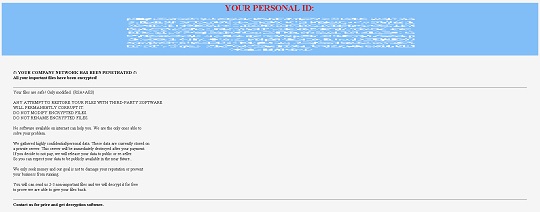Ransom.Win32.MEDUSALOCKER.THIBHBC
Windows


Threat Type: Ransomware
Destructiveness: No
Encrypted:
In the wild: Yes
OVERVIEW
This Ransomware arrives on a system as a file dropped by other malware or as a file downloaded unknowingly by users when visiting malicious sites.
It drops files as ransom note. It avoids encrypting files with the following file extensions.
TECHNICAL DETAILS
343,552 bytes
EXE
No
28 Sep 2023
Disables AV, Encrypts files, Modifies system registry, Terminates processes
Arrival Details
This Ransomware arrives on a system as a file dropped by other malware or as a file downloaded unknowingly by users when visiting malicious sites.
Installation
This Ransomware adds the following processes:
- To delete backup files:
- vssadmmin.exe Delete Shadows /All /Quiet
- wbadmin delete backup -keepVersion:0 -quiet
- wbadmin DELETE SYSTEMSTATEBACKUP
- wbadmin DELETE SYSTEMSTABACKUP -deleteOldest
- wmic.exe SHADOWCOPY /nointeractive
- bcdedit.exe /set {default} recoverynabled No
- bcdedit.exe /set {default} bootstatuspolicy ignoreallfailures
- rem Kill \"SQL\"
- taskkill -f -m {Target process}
- net stop {Target service}
- taskkill /f /im explorer.exe
- start explorer.exe
- cipher /w\?\{Drive letter}: → removes deleted files permanently
- %System%\cmd.exe /c pause
- {Malware file path} -network
(Note: %System% is the Windows system folder, where it usually is C:\Windows\System32 on all Windows operating system versions.)
Autostart Technique
This Ransomware adds the following registry entries to enable its automatic execution at every system startup:
HKEY_CURRENT_USER\Software\Microsoft\
Windows\CurrentVersion\Run
BabyLockerKZ = {Malware file path}
Other System Modifications
This Ransomware adds the following registry entries:
HKEY_LOCAL_MACHINE\SOFTWARE\Microsoft\
Windows\CurrentVersion\Policies\
System
EnableLinkedConnections = 1
HKEY_CURRENT_USER\Software\PAIDMEMES
PUBLIC = {Ransomware public key}
HKEY_CURRENT_USER\Software\PAIDMEMES
PRIVATE = {Ransomware private key}
Process Termination
This Ransomware terminates the following services if found on the affected system:
- via net stop:
- MSSQL$ISARS
- MSSQL$MSFW
- SQLAgent$ISARS
- SQLAgent$MSFW
- SQLBrowser
- REportServer$ISARS
- SQLWriter
It terminates the following processes if found running in the affected system's memory:
- via taskkill /f /im:
- sqlbrowser.exe
- sql writer.exe
- sqlserv.exe
- msmdsrv.exe
- MsDtsSrvr.exe
- sqlceip.exe
- fdlauncher.exe
- Ssms.exe
- SQLAGENT.EXE
- fdhost.exe
- ReportingServicesService.exe
- msftesql.exe
- pg_ctl.exe
- postgres.exe
Other Details
This Ransomware adds the following registry keys:
HKEY_CURRENT_USER\Software
PAIDMEMES =
It does the following:
- Empties Recycle Bin.
- it encrypts fixed, removable and network drives.
- It shows its logs within the command prompt:

It accepts the following parameters:
- -network
- -shares={Network shares to encrypt} → Encrypts specified network shares
- -path={Path to encrypt} → Encrypts specified path
Ransomware Routine
This Ransomware avoids encrypting files with the following strings in their file name:
- How_to_back_files.html
It avoids encrypting files with the following strings in their file path:
- \$Recycle.Bin\
- \Recovery\
- \System Volume Information\
- \Windows\
- \$WinREAgent\
- \$Windows.~WS\
- \$WINDOWS.~BT\
It avoids encrypting files found in the following folders:
- C:\Users\{Username}\AppData\Roaming
- C:\Users\{Username}\AppData\Local
- C:\ProgramData
- C:\perflogs
- C:\Intel
- C:\HP
- C:\AMD
- C:\Dell
- C:\Drivers
- C:\inetpub
- B:\Boot
- A:\Boot
- B:\EFI
- A:\EFI
It appends the following extension to the file name of the encrypted files:
- {original filename}.{original extension}.meduza24
It drops the following file(s) as ransom note:
- {Encrypted Directory}\How_to_back_files.html

It avoids encrypting files with the following file extensions:
- .exe
- .dll
- .sys
- .ini
- .rdp
- .lnk
- .bmp
- .mov
- .cab
- .meduza24
SOLUTION
9.800
18.724.03
28 Sep 2023
18.725.00
29 Sep 2023
Step 1
Trend Micro Predictive Machine Learning detects and blocks malware at the first sign of its existence, before it executes on your system. When enabled, your Trend Micro product detects this malware under the following machine learning name:
- Ransom.Win32.TRX.XXPE50FFF073
Step 2
Before doing any scans, Windows 7, Windows 8, Windows 8.1, and Windows 10 users must disable System Restore to allow full scanning of their computers.
Step 3
Note that not all files, folders, and registry keys and entries are installed on your computer during this malware's/spyware's/grayware's execution. This may be due to incomplete installation or other operating system conditions. If you do not find the same files/folders/registry information, please proceed to the next step.
Step 4
Delete this registry value
Important: Editing the Windows Registry incorrectly can lead to irreversible system malfunction. Please do this step only if you know how or you can ask assistance from your system administrator. Else, check this Microsoft article first before modifying your computer's registry.
- In HKEY_CURRENT_USER\Software\Microsoft\Windows\CurrentVersion\Run
- BabyLockerKZ = {Malware file path}
- BabyLockerKZ = {Malware file path}
- In HKEY_LOCAL_MACHINE\SOFTWARE\Microsoft\Windows\CurrentVersion\Policies\System
- EnableLinkedConnections = 1
- EnableLinkedConnections = 1
- In HKEY_CURRENT_USER\Software\PAIDMEMES
- PUBLIC = {Ransomware public key}
- PUBLIC = {Ransomware public key}
- In HKEY_CURRENT_USER\Software\PAIDMEMES
- PRIVATE = {Ransomware private key}
- PRIVATE = {Ransomware private key}
Step 5
Delete this registry key
Important: Editing the Windows Registry incorrectly can lead to irreversible system malfunction. Please do this step only if you know how or you can ask assistance from your system administrator. Else, check this Microsoft article first before modifying your computer's registry.
- In HKEY_CURRENT_USER\Software\PAIDMEMES
Step 6
Search and delete these files
- {Encrypted Directory}\How_to_back_files.html
Step 7
Scan your computer with your Trend Micro product to delete files detected as Ransom.Win32.MEDUSALOCKER.THIBHBC. If the detected files have already been cleaned, deleted, or quarantined by your Trend Micro product, no further step is required. You may opt to simply delete the quarantined files. Please check the following Trend Micro Support pages for more information:
Step 8
Restore encrypted files from backup.
Did this description help? Tell us how we did.

